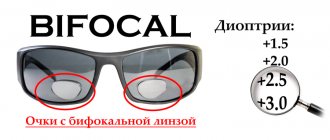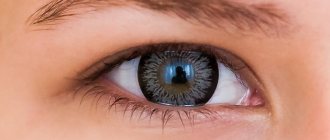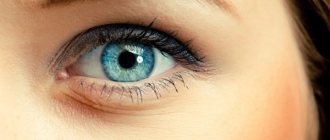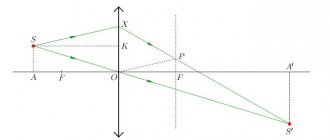Bifocal glasses are glasses whose lenses have two sharply separated optical zones. One (the upper one) is intended for distance, the lower one is for close-up, looking at small objects, reading. The lower part of the lens (called the “window”) can be of any shape and size.
Bifocals are useful in cases where you need to quickly change the focus of your gaze from far distance to near without using your hands, moving your head or wasting time. They are often used for professional purposes by jewelers, programmers, for proofreading small text, defect inspectors, etc.
Bifocal glasses
The effect of quickly changing sharpness can only be obtained with such lenses. The boundary separating the zones of the lens with different properties is very clear, and using such glasses is very convenient.
Changing the focus is done simply, with one movement of the eyes, so that the center of the pupil falls on either the lower or upper part of the common lens. Adjustment of the eye is carried out instantly. This is in contrast to multifocal glasses, in which, when the eye moves from one zone to another, the change occurs gradually, but at the same time distortions and cloudy fields appear at the boundaries of the zones, since the eye itself is not capable of quickly changing focus.
Focus can be changed with one eye movement
Operating principle
Thanks to bifocal lenses for glasses, a person does not need to carry several pairs at once. It is enough to focus your gaze on one of the parts of the glass to clearly see near and distant objects.
Manufacturers pay special attention to the lower lens; it is this that helps to distinguish close objects. A person often examines various objects close up, both at home and at work. The location of such a lens on the bottom of the glass is not accidental. When looking at close objects, a person most often looks down. Only sometimes an optical device for viewing objects closely is placed at the top of the glass. Such glasses are often used by watchmakers, jewelers and representatives of other professions in which working with small details is important.
It happens that the top part is made of ordinary glass. These glasses are necessary for people who suffer only from myopia. The lower lens can be of completely different sizes and shapes. It can occupy either half of the glass or a small part.
Bifocals help people with vision problems see objects at different distances.
Bifocal lenses for glasses
Correcting age-related changes in vision can be complicated if a person has other vision pathologies. You will need several pairs of glasses. Some have to be worn constantly, they help to see well into the distance, while others are worn only when reading, viewing photographs, working at the computer, etc. It is very inconvenient to keep two pairs of optical products with you. The invention of bifocal glasses solved this problem.
Bifocals are glasses that allow a person to see at different distances. The lenses in them are divided into two halves. Moreover, the dividing strip is clearly visible. The upper segment is responsible for distance vision. In this case, for people with good vision, the upper part of the lens may be ordinary glass. For myopic people it will be with negative, or “minus” diopters. The lower segment is equipped with positive optical power and corrects age-related farsightedness, that is, it improves close focusing.
Bifocal lenses have one undeniable advantage. They eliminate the need to wear multiple pairs of glasses. But such optics also have disadvantages:
- unaesthetic appearance of lenses;
- sharp transition between close and far distances;
- lack of optical zone for medium distance.
Bifocals may cause fatigue after reading. Many people don't like this optic because it doesn't look aesthetically pleasing. Is there an alternative to bifocal lenses? They can be replaced with trifocals or progressive glasses.
Advantages and disadvantages
Bifocal glasses have both their advantages and disadvantages. The advantages include the following points:
- A person with poor eyesight does not need to wear several pairs.
- You can buy them at an affordable price, which is not much different from the cost of ordinary glasses.
- You can choose optics taking into account the characteristics of a person.
Such glasses are considered multifunctional, but since the design was developed a long time ago, some nuances were not taken into account. So, in some cases, a person needs to use the central gaze zone for a long time, for example, when driving a vehicle. This is difficult to do with bifocal glasses. For this type of activity, you need trifocal glasses, in which the glass is divided into 3 lenses with different refractions of light. Disadvantages include the following factors:
- Lenses refract the human eye. For an outside observer, this does not look very aesthetically pleasing, since one part of the eye is small and the other is large. For some people, this state of affairs is completely unacceptable.
- Constantly switching from one lens to another causes your eyes to become very tired. To reduce eye strain, the difference in diopters is made no more than 5.
- The adaptation period may take a long time.
- For some people, wearing such glasses leads to nausea and frequent migraines.
Progressive lenses are also used to reduce eye strain. In this case, the transition is smooth, there are no sharp boundaries.
If you compare the benefits and harms of bifocal glasses, you can see that there are more positive aspects. If, while wearing it, a person notices that their eyes become very tired or that it is uncomfortable to look through the lenses, the doctor should be informed about this.
An ophthalmologist should select glasses. After conducting a series of examinations of the patient.
What is presbyopia?
It occurs in all people and is associated with the aging of the body.
The accommodative apparatus consists of the lens, ciliary muscle and ligament of cinnamon. These structures of the eyeball are responsible for focusing. Depending on whether a person looks near or far, the muscles tense or relax, and the lens bends, which leads to a change in its refractive power. Thanks to the work of the accommodative apparatus, we see at different distances without noticing the focusing itself.
At birth, a person's lens is perfectly transparent and very elastic. This allows him to change his shape. Over the years it becomes more dense. In addition, the eye muscles, which are responsible for its deformation, weaken. Because of this, presbyopia develops, in which vision at close range is impaired. A person has difficulty reading, as a result of which this defect is called age-related farsightedness. Requires glasses with positive diopters that magnify the image.
This is not the only symptom of presbyopia. It causes asthenopia - increased eye fatigue, which manifests itself in the following symptoms:
- headache;
- heaviness in the eyes;
- rapid fatigue of the body;
- redness of the sclera after reading or working at the computer.
The onset of presbyopia is inevitable. There is no way to prevent this problem. But there are a number of factors that contribute to its earlier appearance:
- hypermetropia;
- astigmatism;
- eye surgeries;
- ultraviolet radiation;
- constant visual stress;
- various systemic diseases: diabetes, anemia, etc.
Presbyopia may occur a little later in people who are nearsighted. In any case, every person after 40 years will encounter age-related farsightedness. The symptoms listed earlier are only part of the problem. If left uncorrected, presbyopia can lead to the development of glaucoma. This pathology can lead to very serious consequences, including blindness. Wearing glasses not only helps compensate for refractive error, but also serves as a way to prevent complications of presbyopia.
For what diseases are they needed?
Bifocal lenses are recommended for people who have difficulty seeing objects near and far. Such lenses are useful for people who simultaneously use several pairs of glasses with different diopters. Sometimes this type of glasses is prescribed for astigmatism.
Bifocal glasses are often prescribed for presbyopia.
Such optics are often used by people of specific professions who need to examine very small objects up close. You can see bifocal lenses in watchmakers and jewelers.
What are bifocals used for?
Most people with poor vision have several pairs of glasses. They need some for reading newspapers and books, others for watching TV, and others for walking. Changing vision correction means causes certain inconveniences. To make life easier for visually impaired people, bifocal glasses were created. They simultaneously combine different diopters. Lenses have areas with different degrees of light refraction. They become a godsend for people whose myopia is complicated by farsightedness.
How to get a prescription
Bifocal glasses should only be prescribed to a person by an ophthalmologist. At the same time, attention is focused on the following points:
- The glasses model is selected individually. The optics that are ideal for one person may not be suitable for others to wear.
- If optics are used for different purposes, you should consider purchasing a pair of these glasses. This is true for drivers and teachers. The latter need to often look at the class, focusing their vision in the middle segment. But when checking notebooks, the eyes look down.
- If a person is not satisfied with the aesthetic side of the issue, then he can ask the doctor to prescribe bifocal lenses. They do not distort the shape of the eye at all and are almost not felt.
There are two types of bifocal lenses - linear and progressive. A characteristic feature of the former is a horizontal line, which usually runs clearly in the middle. With the second type of optics, focus shifts smoothly.
It is worth considering that getting used to such optics can be extremely problematic. The adaptation process may take several weeks.
Multifocal lenses - what are they?
They are designed in the same way as bifocal glasses or progressive lenses, that is, they are equipped with 2-3 optical zones. At the same time, modern models of contact optics with a multifocal design are so high-tech that they themselves adapt to the human brain. They determine where the eye is directed and provide a high-quality image. All this happens so quickly that a person does not notice anything.
Multifocal lenses are used to correct not only presbyopia, but also other refractive errors. They can be worn if you are nearsighted. Today, the choice of such ophthalmic products is very diverse. Let's list a few popular models:
- 1-Day ACUVUE Moist Multifocal - one-day lenses made of hydrogel material with a high level of moisture content - 58%.
- Clariti 1 day Multifocal is a one-day ophthalmic product that can be worn flexibly.
- Air Optix Aqua Multifocal is a contact optic designed for a month.
- Dailies Total 1 Multifocal are disposable multifocal lenses made of water-gradient material. They allow a lot of oxygen to pass through and are perfectly hydrated.
There is also a method for correcting presbyopia called monovision, in which a lens is worn on one eye for near vision and on the other eye to improve distance vision. If bifocal glasses and multifocal ophthalmic products are not suitable for a person, then laser surgery is the solution.
Contraindications
Such optics may not be prescribed by an ophthalmologist in all cases. There are a number of contraindications that are taken into account when selecting glasses. Bifocals should not be worn by people with the following problems:
- For cataracts.
- When the visual acuity of the right and left eyes is very different, the difference is more than 2 diopters.
- With severe strabismus.
- In case of individual intolerance to corrective lenses.
- With nystagmus. This disease is manifested by involuntary twitching of the pupils.
It is not recommended to purchase and use optics without a doctor's prescription. This can lead to blurred vision and a number of side effects.
If, due to the type of activity, a person rarely examines small objects up close, then for a minus lens it is enough to select a small area closer to the bridge of the nose.
Varieties
Currently, multifocal glasses are divided into two main types:
- Classic bifocals with a dividing strip in the middle, separating different optical zones.
- Progressive. This type of glasses does not have a completely horizontal division and, instead of a boundary between zones, has a special corridor with a smooth transition between diopters. This variety, however, retains the basic principle of such optics, having a zone for working at short distances and a segment for working with objects located far away.
Also, the types of lenses presented are further divided into standard and ultra-thin, regular and tinted, as well as photochromic (chameleon). Underlying types of lenses may additionally have various filters, thanks to which they will protect your eyes from exposure to ultraviolet radiation or any other unfavorable external factors.
Prices for bifocal glasses depend on all of the above factors, as well as on the materials from which they were made and the brand that produces the products presented. They may differ in different optical stores, but usually range from several hundred to several thousand rubles.
How to choose
The doctor selects the optics. First, he determines how much refractive power is needed for each lens. In many cases, a minus lens is placed at the bottom of the glasses, and a zero lens is placed at the top, which does not refract at all. Such glasses are ideal for cases of classic myopia, when close objects are poorly visible, and viewing distant objects does not cause difficulty.
For older people who already have difficulty seeing not only near, but also in the distance, the doctor prescribes bifocal glasses with a minus lens at the bottom and a plus lens at the top. In some cases, the negative glass is made small.
Sometimes doctors have to prescribe bifocal glasses with a minus lens located at the top of the frame. Such optics are necessary for those people who, due to their occupation, often look at small objects located above eye level.
The size of the lenses is determined by the doctor individually. So if a person often reads newspapers and books, then the negative lens should occupy about half of the total area. If the patient often contemplates objects located in the distance, then a plus lens is made larger.
Ophthalmologists more often recommend progressive lenses to patients. They look more aesthetically pleasing, are easy to get used to and guarantee a more natural visual experience.
Reviews
Before choosing the most suitable option for glasses and deciding whether to use them or not, you can always read the reviews of those who already use them.
Svetlana 33 years old
More than a month ago I bought glasses with double lenses, or bifocals as they are called. I can’t say that I’m 100% happy with the result; I just can’t get used to them. No, the image clarity that I expected. I hope something will change over time.
Nikolay 49 years old
For more than 10 years I have used two pairs of glasses separately for near and distance. With the advent of bifocals, my life changed. I am very glad that my doctor recommended them to me. I got used to them for about a week, now everything is fine. The eyes do not get tired or hurt. I can say with confidence that this is my best purchase in the last few years.
Gennady 41 years old
I'm not entirely happy with these glasses lenses that the doctor picked out. You have to constantly strain your eyes to focus, and also raise and lower your head if you need to read or watch something. Perhaps it’s a matter of time, but at the moment I continue to use two pairs of glasses.
Lyudmila 29 years old
I ordered bifolar glasses with a custom design. Overall, I'm happy with everything. There was no long adjustment or any unpleasant sensations. An excellent solution for those who want to forget about two pairs of glasses forever.










